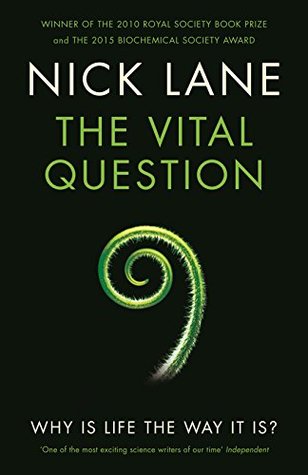More on this book
Community
Kindle Notes & Highlights
leaky membranes can use natural proton gradients to power carbon and energy metabolism.
Methanogens spend practically 98% of their energy budget on generating proton gradients by methanogenesis, and
In theory, the antiporter could convert a natural proton gradient into a biochemical sodium gradient.
An antiporter improves the situation because it increases the power available from a natural proton gradient, but it does not cut off the cell from its dependence on the natural gradient.
Overall, the energy released by the reaction of H2 and CO2 powers the extrusion of protons across a membrane.
But in the preceding aeons, we had 2 billion years of peace and symbiosis, bacterial love (and not only love), and what did this infinity of prokaryotes come up with?
Proton gradients have become the ultimate sensors of cellular health, the arbiters of life and death,
So scaling up a bacterium to the size of an average eukaryote increases ATP synthesis by 625-fold, but increases the energy costs by up to 15,000-fold.
only the evolution of sex in a small unstable population can explain why all eukaryotes share so many common traits.
Orthologs are basically the same genes doing the same job in different species, inherited from a common ancestor, as
The second group of genes, paralogs, also share a common ancestor, but in this case the ancestral gene was duplicated within the same cell, often on multiple occasions, to give a gene family.
inside the nucleus, genes are transcribed into RNA codescripts; outside the nucleus, the RNAs are translated into proteins on the ribosomes.
accumulation of mildly damaging mutations, and loss of variation in selective sweeps – are together known as selective interference.
the benefits of sex are greatest when the mutation rate is high, selection pressure is strong, and there is a lot of variation in a population.
The larger the genome, the harder it becomes to pick up the ‘correct’ gene by lateral gene transfer;
One of the deepest distinctions between the two sexes relates to the inheritance of mitochondria – one sex passes on its mitochondria, while the other sex does not. This
mixing two populations of mitochondria in the same cell is just asking for trouble.
Much better, from the dispassionate view of natural selection, to halt development early, before too many resources have been dedicated to the new individual, than to allow development to run to full term.
male has two different sex chromosomes – an X and a Y chromosome. Female mammals have two X chromosomes, and are therefore homozygous for their sex chromosomes (homogametic).
for birds and some insects. Here the female is heterogametic, having a W and a Z chromosome, whereas the male is homogametic, with two Z chromosomes.
The free-radical theory of ageing argues that ageing is caused by free-radical leak: the faster the rate of free-radical leak, the faster we age.
Antioxidants interfere with the noxious effects of free radicals, blocking the chain reactions, and so preventing the spread of damage.
If free radicals cause ageing, antioxidants should slow it down, delaying the onset of diseases and perhaps prolonging our lives.
Blocking free-radical signals with antioxidants is hazardous and can suppress ATP synthesis in cell culture, as
They can suppress respiration in cell culture because the normal safeguards imposed by the body are not present in cell culture.
remains similar or even goes down, because the proportion of radicals leaked relative to oxygen consumed falls off considerably.
That happens because electron flux speeds up in the respiratory chains, meaning that the respiratory complexes become less reduced, and so are less likely to react directly with oxygen
Death is the ceasing of electron and proton flux, the settling of membrane potential, the end of that unbroken flame.
If life is nothing but an electron looking for a place to rest, death is nothing but that electron come to rest.


